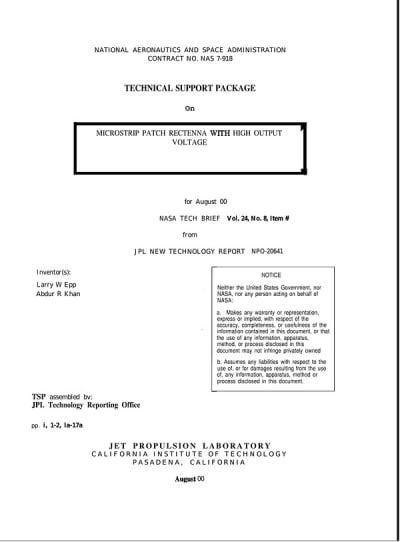A prototype dual-polarization microstrip patch rectenna dimensioned for an operating frequency of 8.51 GHz has been built to demonstrate a design concept for obtaining maximum output voltage from a rectenna of a given size. This rectenna contains nine square microstrip patch antenna elements in a square array. The antenna can utilize incident radiation with polarization components parallel to either or both sides of the square because the circuitry under each patch includes two independent rectifiers — one for each polarization component. The dc output terminals of the two rectifiers under each patch are connected in series, and the series rectifier pairs of all patches are connected in series. Consequently, the maximum output voltage (obtainable in the special case of circularly polarized incident radiation) can be 18 times that generated by a single-rectifier, single-polarization patch element.
Each microstrip patch antenna element is supported over a ground plane by a layer of lightweight foam with a low (1.07) permittivity. Microstrip feed circuitry, rectifier diodes, and dc conductors that collect the output power are located below the ground plane. Microwave energy is coupled from the antenna elements to the feed circuitry through apertures or coupling slots. Except for this aperture coupling, the antenna and the microstrip feed circuitry are divorced from each other.
The placement of the feed and rectifier circuitry below the ground plane makes it possible to isolate the rectifier circuitry from direct exposure to the incident microwave energy and thus prevents spurious coupling of microwave energy onto the dc conductors. The ground plane also prevents the direct reradiation of the harmonics that are generated by the diodes as unavoidable byproducts of rectification. A microstrip line filter is used to prevent radiation back through the aperture feed. Yet another advantage of mounting the rectifier circuitry below the ground plane is that the ground plane serves as an effective thermal sink for the diodes. The ground plane is not a single conductive plane but, rather, an array of dc-isolated, capacitively-coupled islands registered with the overlying antenna patches. The capacitive coupling is effected by a thin layer of copper-coated polyimide. The dc isolation of the ground-plane islands in conjunction with the orthogonality of the layout makes it possible to use these islands as parts of the series-connected dc output circuitry.
In tests at an optimized load resistance of 5.4 k Ω , the rectenna was found to function with an overall energy-conversion efficiency exceeding 52 percent over a large range of incident power densities, with a peak of 53 percent at a power density of 38.8 mW/cm2. The results of the tests also showed that a target output potential of 50 Vdc can be achieved at a power density of 25.2 mW/cm2.
This work was done by Larry Epp and Abdur Khan of Caltech for NASA's Jet Propulsion Laboratory. For further information, access the Technical Support Package (TSP) free on-line at www.nasatech.com/tsp under the Electronic Components and Systems category.
In accordance with Public Law 96-517, the contractor has elected to retain title to this invention. Inquiries concerning rights for its commercial use should be addressed to
Technology Reporting Office, JPL, Mail Stop 122-116, 4800 Oak Grove Drive, Pasadena, CA 91109, (818) 354-2240.
Refer to NPO-20641, volume and number of this NASA Tech Briefs issue, and the page number.
This Brief includes a Technical Support Package (TSP).

Microstrip Patch Rectenna with High Output Voltage
(reference NPO-20641) is currently available for download from the TSP library.
Don't have an account?
Overview
The document outlines a technical support package related to a novel microstrip patch rectenna developed at NASA's Jet Propulsion Laboratory (JPL). The invention, credited to inventors Larry W. Epp and Abdur R. Khan, focuses on a compact, dual-polarized rectenna designed to operate at a frequency of 8.51 GHz. This technology aims to enhance output voltage, making it particularly relevant for applications in wireless power transmission and energy harvesting.
The document includes a patent rights status section, indicating that a written description of the invention has been completed and is intended for submission to the "IEEE Transactions on Microwave Theory and Techniques." It also notes that no disclosures of the technology have been made outside of JPL or NASA Langley, except for potential discussions with Norfolk State University regarding the purchase of rectenna panels.
The rectenna's design features nine square microstrip patch antenna elements, which are arranged to optimize the collection of incident radiation. This innovative configuration is expected to yield a significantly higher output voltage compared to traditional rectenna designs, thereby improving efficiency in converting microwave energy into usable electrical power.
The document emphasizes the importance of proper dissemination of the technology, suggesting that publication in NASA Tech Briefs is necessary but should be complemented by additional publication in an IEEE journal or equivalent. This approach aligns with NASA's practices for sharing technological advancements with the industry.
Furthermore, the document includes disclaimers regarding the accuracy and completeness of the information provided, stating that neither the U.S. Government nor NASA assumes liability for any damages resulting from the use of the disclosed information. It also clarifies that references to specific commercial products or services do not imply endorsement by the U.S. Government or JPL.
Overall, this technical support package serves as a comprehensive overview of the microstrip patch rectenna's development, its potential applications, and the steps taken to protect and disseminate the associated intellectual property. The advancements presented in this document highlight JPL's commitment to innovation in semiconductor microelectronics and wireless energy technologies.

